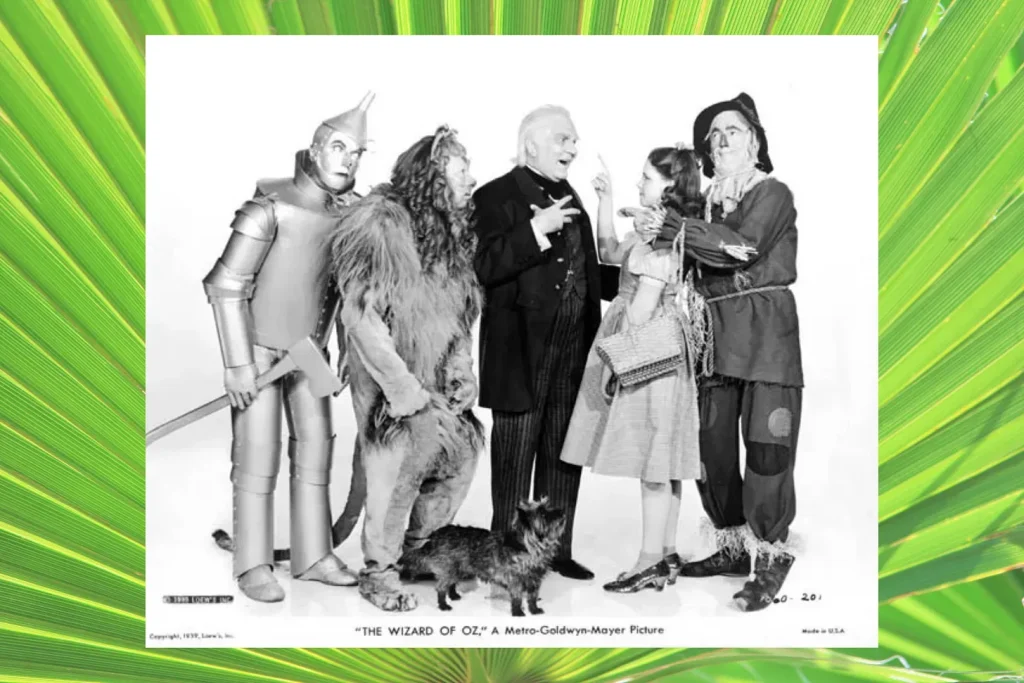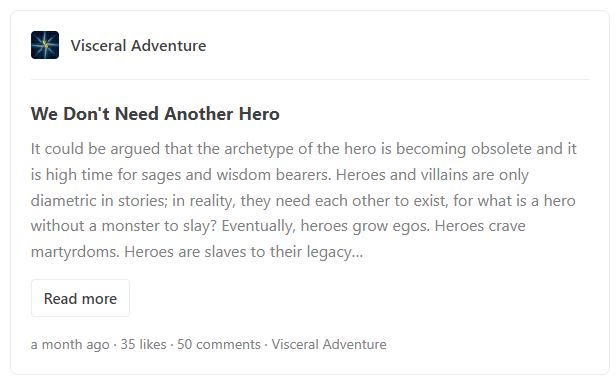Electing the Wizard, Revisited: The Wizard of Oz just gets more and more relevant

In 2016, just before Trump was elected, I wrote a piece entitled Electing the Wizard. Last week, a few of my favorite Substackers wrote essays that convinced me to dive back into it. So here is a new take, re-tooled to incorporate ideas that didn’t occur to me seven years ago. A lot can happen in just a few years, no?

I love The Wizard of Oz. The movie, that is. The book was compelling, too, and it apparently inspired an interpretation in the 1960s as political allegory of populist sentiment. But it was the movie that took hold of my heart. How could it not? Every year, from 1959-1991, The Wizard of Oz was broadcast on commercial network television here in the US.
I looked forward to it every year, even though I had a complicated emotional relationship with it. I can remember running out of the den in terror as a 5- 6- and 7-year-old every time the Wicked Witch made an appearance, and waiting for the “all clear” signal from my parents to return.
I remember thinking that I wanted to be Glinda, with her beatific eyes and sparkly magic wand, and travel around in an iridescent bubble doing good deeds. I also remember the unfamiliar combination of horror and fascination as I watched the Wicked Witch melt down to a sizzling hat and cloak, transfixed by her screeching demise.
Now that I think of it, perhaps it was because of my complicated emotional relationship that I became deeply attached to it.
Let’s not go there. Not yet, anyway.
Instead, let’s look at the oodles of analogies that have been, and can be, drawn from the movie. There are some big lessons for us here.
In February of 2016, writer/filmmaker Geoffrey Dunn characterized then-presidential nominee Donald Trump as the Wizard, claiming:
“Trump has become the modern-day version of the Wizard, hiding behind a phalanx of curtains and screens, pulling his levers and twisting his wheels to create a fraudulent illusion of power and influence.
…Trump’s political legitimacy is all smoke and mirrors — the polls, the polls, the polls — and, most of all like the Wizard’s, founded on deception and fueled by fear.”
I’m sorry, but how many big-name politician running for office can you name who haven’t relied on polls?
Dunn goes on:
“Trump’s appearances before his rabid supporters are staged and controlled. He never allows the American public behind the curtains. His act is all a carefully crafted construction, a fiction…”
Show me a politician whose act isn’t. All of our politicians are grand holograms, projected and held aloft by spin doctors and handlers and PR specialists, abetted by a slavish media who ensure that the curtain stays firmly drawn.
It’s all a majestic show, and we’ve been buying the tickets forever. Don’t get me wrong; some of these Wizards have been more likable than others, or seemingly trustworthy, or even inspirational. I cried when Obama gave his nomination acceptance speech in 2008.

I also conveniently ignored the ginormous replica of a greek temple, complete with fluted columns recreated on a football field to serve as his backdrop. Talk about creating the illusion of power and influence.
When we pull back the lens, it becomes clear that the Great and Powerful Oz analogy must be widened to include all modern politicians on the national stage, left or right, red or blue. And it doesn’t just apply to these individuals while they’re running for office; once they’re there, they burrow deep. Self-preservation kicks in.
The phrase “uniparty” has been making the rounds lately: instead of two separate parties, there’s just one big blob of elites running the place. Is that true? I can’t know for certain. But the bipartisan support for withholding security footage of the January 6th event for over two years certainly leads me to believe it is.
Our esteemed lawmakers from both sides of the aisle, like the hapless Wizard, have been falling all over themselves to CLOSE THE CURTAIN. Don’t let the riffraff see what agnostic security cameras recorded! Don’t introduce evidence that might make us look bad! Don’t go off script! Pay no attention to that man behind the curtain!
Freedom, true freedom, is being able to look behind any curtain we damn well please, and draw whatever conclusions we want. That’s pretty much what “of the people, by the people, for the people” is supposed to mean, isn’t it?
Dorothy and her pals decide that the beleaguered man behind the curtain is “a very bad man,” and tell him so. The washed-up magician from Kansas replies meekly, “Oh, no my dear, I’m a very good man. I’m just a very bad wizard.”
I’m inclined to believe that the Capitol building houses a percentage of both — and it has nothing to do with party affiliation. But without transparency, how will any of us determine what that percentage really is?
The Wizard did indeed have the very best intentions when, as he describes it, the wind changed, blowing his hot-air balloon off course from the Omaha State Fair and into Emerald City where the townspeople — accustomed as they were to magical beings arriving from the sky — immediately hailed him “Oz, the first Wizard Deluxe.”
This midwestern magician, with presumably no leadership skills or experience, accepted the mantle of responsibility to lead the place, and did so as a “good man but a bad wizard.” He ruled from behind the curtain, compassionately, with a forbidding exterior to ensure his anonymity. The result? A city of infantilized citizens.

Normally I separate out my poems from my essays. But this one I started years ago feels too perfect not to finish and include here:
Emerald City
As a child, I wanted to live
in that magical town
where the folk in green
ha ha ha and
ho ho ho
their way through life,
day in, day out;
where jolly workers pat and rub
and clip and polish, trilling about
keeping us young and fair,
because self-care seems imperative;
where they laugh the day away,
breezy and carefree
because they’re ruled by a talking orb
that no one sees
or knows
or questions;
ha ha ha,
ho ho ho
and a couple of tra la las!
Where crickets chirp
and no one works
except the jolly ones
in the service industry
and no one is old
in the jolly old town;
where ha ha ha crescendoes,
squeezed to manic hilarity,
ho ho ho
being the only logical expression
of an endless childhood
sweetly enforced
tra la la la la
from above.
I no longer want to reside
in the merry old land of Oz
because somewhere along the way
thank god
I grew up.
The Emerald City is a child’s fantasy, a place where everyone is happy all the time and no one works — the result of the Wizard’s inherent goodness. (Guaranteed income, anyone?) What would it have looked like if he were, in fact, a bad man? There are plenty of historical examples of ruling by force and by fear, but the Wicked Witch of the West shows us one vivid possibility: enslaved flying monkeys and a grimly marching military detail that follows orders but secretly despises their cackling green leader.
I don’t have answers for the corruption-of-leadership problem across all our once-trusted institutions. All I have are some insights drawn from an iconic, deeply metaphorical movie and the writings of a few Substack pals.
First, and goddess knows I’m not the first to say it: we are suffering from a systemic lack of transparency, as I’ve laid out above. For any trust to be restored, or instated in any organization, the curtains must go.
Second, I agree with this excellent piece by Visceral Adventure. The notion of “leader-as-hero” has reached its evolutionary usefulness:
In it, the author states:
“Eventually, heroes grow egos. Heroes crave martyrdoms. Heroes are slaves to their legacy…Heroes lose their heads often because they can’t see the story outside of the role they play in it…”
I think she’s absolutely right. We’ve run the categories, many times over, on the hero archetype, and it’s time for different kinds of leadership to emerge — kinds we rarely see, as enamored of hero-worship as we are.
(There’s a cool interplay between the Hero’s Journey and other mythical models like the Heroine’s Journey, but in the interest of space, I’ll save it for another essay.)
One such kind is “Servant Leadership,” a term I learned while facilitating consensus within Waldorf communities. It’s not a new idea (Robert K. Greenleaf coined that term in an essay he published in 1970), but it’s one we need now more than ever.
Defined as leadership that focuses on the growth and well-being of the community,
“servant leadership is different. The servant-leader shares power, puts the needs of others first and helps people develop and perform as highly as possible.” —Robert K. Greenleaf
As Visceral Adventure describes, we no longer need the charismatic Superman who sweeps out of the sky to our rescue, single-handedly solves problems, and makes everything okay:
“Instead of the archetype of the hero taking on this leadership role, it’s that of the wise (wo)man/the sage/the teacher who are to lead with integrity and compassion. Not for fame or fortune or clout but to be of service to their fellow travelers, to help humanity grow into the grandest coming-of-age story yet.”
It’s Dorothy Gale, the nobody from Kansas who, despite the power endowed by the ruby slippers, doesn’t lord it over her three traveling companions; she’s not interested in wielding power for its own sake.
Linked arm-in-arm with her friends, she skips down the yellow brick road, making consensus-based decisions with them on the fly (to the left? to the right? let’s go straight up the middle!).
Dorothy never looks out solely for number one. To the contrary, she is more concerned about making sure their needs are met (a brain, a heart, “the noive”) than she is about meeting her own need (getting back home to Kansas).
One of my favorite scenes takes place in the great hall, when the four of them encounter the Great and Powerful Wizard for the first time. The flaming, floating apparition hurls alliterative insults at each of them in turn (to Scarecrow: “you billowing bale of bovine fodder!”), then finally addresses Lion. The angry disembodied head has only to say, imperiously, “WELL??” and the big scaredy cat faints dead away, flattened to the marble floor.
Rushing to the unconscious coward’s side, Dorothy can’t help herself. She lashes out at the Wizard, “You oughta be ashamed of yourself! Frightening him like that when he came to you for help!”
In that moment, Dorothy’s concern for Lion overpowers any concern she has for her own safety. She is brave and strong in the face of grave danger, because her love for her friend makes her so. In that moment, servant leadership shines.
We see a different leadership model take shape toward the end of the movie, too, within the Wizard’s governance succession plan for the Emerald City. When the Wizard decides to shake out the old mothballed balloon and head back to Kansas with Dorothy, whom does he leave in charge?
“The Scarecrow, by virtue of his highly superior brains, shall rule in my stead, assisted by the Tinman, by virtue of his magnificent heart, and the Lion, by virtue of his courage,” says the departing Wizard. And thus the government of the land of Oz evolves beyond benevolent dictatorship into competence hierarchy.
Notice that for it to work, good, competent people (Scarecrow, Tinman, and Lion) have to step up to serve as leaders. As citizens we have to accept, like Dorothy and her pals eventually did, that we can’t show up at the doorstep of a Wizard with our problems and expect solutions.
As tempting as it may be to live in an Emerald City, to trust that someone else has all the answers (“Here! Take this responsibility off my hands, won’t you? Think big thoughts and make all the right decisions for me. I’m going back to sleep”), that’s not what’s being asked of us.
Politicians and lawmakers are just like us: deeply flawed human beings who don’t have all the answers. It’s time we stop handing them the power that we ourselves possess. We have the brains, the heart, and the courage — and always have had.
At the end of the movie, Glinda tells Dorothy she’s always had the power to go back to Kansas. Indignant, Scarecrow demands, “Then why didn’t you tell her before?” Glinda responds, wisely, “Because she wouldn’t have believed me. She had to learn it for herself.”
Anyone who offers answers — in the form of miracle fixes, religious certainty, or scientific “fact” — is a powerless wizard that does not deserve our attention, let alone our trust.
Visceral Adventure says this:
Deep down, each and every one of us, knows the way home. Deep down, we know the courage it takes to do the right thing at the right time.
Maybe that’s why I’m deeply attached to this movie. After all these years, Dorothy’s lesson learned by the end of her grand journey still chokes me up: there really is no place like home.
Now seems like an excellent time for all of us to break out our ruby slippers.
This article was republished from the author’s Substack.
One of our country’s most important freedoms is that of free speech.
Agree with this essay? Disagree? Join the debate by writing to DailyClout HERE.






People without brains do an awful lot of talking , don’t ya think ? Scarecrow to Dorothy , after admitting his head is full of straw , but no brains .
Apropos in America these days .
Trump is the Brave Lion not the Cowardly Lion.
History lesson: Who was the Cowardly Lion in real life?
Bill Still: The Secret of Oz – YouTube
2009 Bill Still :What’s going on with the world’s economy? Foreclosures are everywhere, unemployment is skyrocketing – and this may only be the beginning. Could it be that solutions to the world’s economic problems could have been embedded in the most beloved children’s story of all time, “The Wonderful Wizard of Oz”? The yellow brick road (the gold standard), the emerald city of Oz (greenback money), even Dorothy’s silver slippers (changed to ruby slippers for the movie version) were powerful symbols of author L. Frank Baum’s belief that the people – not the big banks — should control the quantity of a nation’s money. Debt free money.
The Secret Of OZ
2009 Bill Still :What’s going on with the world’s economy? Foreclosures are everywhere, unemployment is skyrocketing – and this may only be the beginning. Could it be that solutions to the world’s economic problems could have been embedded in the most beloved children’s story of all time, “The Wonderful Wizard of Oz”? The yellow brick road (the gold standard), the emerald city of Oz (greenback money), even Dorothy’s silver slippers (changed to ruby slippers for the movie version) were powerful symbols of author L. Frank Baum’s belief that the people – not the big banks — should control the quantity of a nation’s money. Debt free money.
The Secret OF OZ -Youtube
“The Wonderful Wizard of Oz”? The yellow brick road (the gold standard), the emerald city of Oz (greenback money), even Dorothy’s silver slippers (changed to ruby slippers for the movie version) were powerful symbols of author L. Frank Baum’s belief that the people – not the big banks — should control the quantity of a nation’s money. Debt free money.